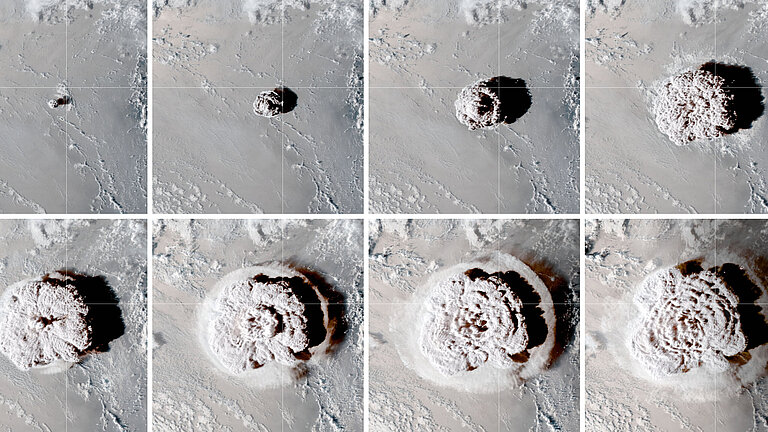GEOMAR Helmholtz Centre for Ocean Research Kiel
Wischhofstr. 1-3
24148 Kiel
GERMANY
Media requests: media(at)geomar.de
Events and all other topics: outreach(at)geomar.de
The eruption of Hunga Tonga-Hunga Ha’apai (HTHH) in January 2022 ejected around 2.9 billion tonnes of volcanic material into the atmosphere and across the South Pacific. In early 2022, a scientific expedition (GEOTRACES GP21) investigated the impact of this monumental event on the biogeochemistry of the South Pacific Gyre (SPG) surface waters. The scientists focused in particular on changes in the concentration of trace elements in the ocean and their influence on marine life. The results of this study have now been published in Nature Communications.
By computer and ship: evidence of volcanic influence in the South Pacific
For a comprehensive analysis of the eruption’s effects, the researchers used a combination of advanced computer simulations and precise sample analysis. To simulate the spread of volcanic ash after the eruption, they used the HYSPLIT computer model from the National Oceanic and Atmospheric Administration (NOAA), a US federal agency. The model simulates the transport of substances in the atmosphere. It was used to calculate the dispersion of volcanic ash at different altitudes for 72 hours and the trajectories of the ash for up to 315 hours.
During the SONNE expedition SO289 as part of the international GEOTRACES programme from February to April 2022, the researchers collected water samples along a designated route to analyse the distribution of trace elements and their biogeochemical effects. A large amount of floating tephra, mostly pumice, was observed and collected in the western SPG during the expedition. Using radiogenic neodymium isotopes and rare earth element concentrations, the researchers were able to fingerprint a marked volcanic input into the western SPG. This is the region identified as the primary site of post-eruption deposition based on the volcanic ash dispersal model. In addition, seawater analyses of neodymium isotopes and rare earth elements were used to track volcanic input and chlorophyll-a as an indicator for phytoplankton.
Phytoplankton Benefits from Trace Elements in volcanic material
In the western SPG the researchers identified significant amounts of trace elements such as iron and neodymium, which normally only enter the ocean in minimal quantities via atmospheric dust. The volcanic eruption released an additional 32,000 tonnes of iron and 160 tonnes of neodymium. The amount of iron is equivalent to what the region normally receives in a year, while the amount of neodymium is equivalent to a year’s worth of global input.
“At the same time, we measured increased chlorophyll-a concentrations in surface waters, indicating increased phytoplankton growth and hence biological activity,” says Dr Zhouling Zhang, a research associate in the Palaeo-Oceanography Research Unit and lead author of the study.
Long-term Climate Implications
The team was able to show that trace elements released by volcanic eruptions play an important role for marine life. These elements, particularly the micronutrient iron, act as nutrients in the ocean that stimulate the growth of phytoplankton. Phytoplankton play an essential role in the global carbon cycle, absorbing CO₂ from the atmosphere through photosynthesis and storing it in the ocean. Increasing biological productivity may therefore also improve the ocean's ability to absorb CO₂ from the atmosphere - a process that could have a long-term impact on climate.
The researchers estimate that the release of the micronutrient iron from the HTHH eruption is comparable to the iron fertilisation caused by the eruption of Mount Pinatubo in the Philippines in June 1991, when around 40,000 tonnes of volcanic material was released and a 1.5 ppm slowdown in the rise of atmospheric CO₂ was measured about two years after the eruption. Zhouling Zhang says, 'We think the Hunga Tonga eruption could have a similar effect.
Original Publication:
Zhang, Z., Xu, A., Hathorne, E. et al. (2024): Substantial trace metal input from the 2022 Hunga Tonga-Hunga Ha’apai eruption into the South Pacific. Nat Commun 15, 8986.

View from space: A NASA Earth observation satellite recorded the different stages of the volcanic cloud on 15 January 2022. Photo: NASA
![[Translate to English:] Light, yellowish dots on a dark water surface](/fileadmin/_processed_/8/c/csm_Photo_1_06aea4ffca.jpg)
The eruption of the undersea volcano Hunga Tonga-Hunga Ha'apai in January 2022 released about 2.9 billion tonnes of volcanic material. This photo of floating tephra, mostly pumice, was taken one and a half months later during the SONNE expedition SO289. Photo: Maria de los Angeles Amenabar, GEOMAR.
![[Translate to English:] Two lumps of stone with shells in a transparent plastic bag with water](/fileadmin/_processed_/6/4/csm_Photo_2_4b4d452b8f.jpg)
New substrate thanks to volcanic eruption: Life had already colonised these pumice blocks. Photo: Te Liu, GEOMAR

